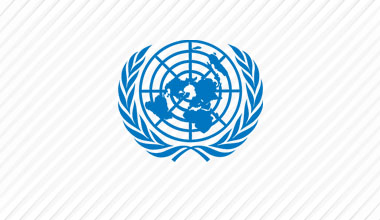Photos and drawings tell 40 years of UNIFIL’s shared history in south Lebanon
In a little room inside Beit al Madina in the southern city of Tyre, drawings of white doves, green trees, sunrise, broken fences, flying birds, and people collecting their harvest would capture your attention. All set in enchanting bright colours by young students, to tell the story of the 40 years of journey undertaken by the people of south Lebanon together with UNIFIL, the drawings were a major attraction at the UNIFIL-organized multimedia exhibition last week.
Hundreds of such drawings by students from 25 schools and 62 photographs spoke for themselves. Together, they told the fascinating story of south Lebanon, which has witnessed a momentous transformation since UNIFIL was deployed in 1978. They told the stories of miseries, wars, endurance, UNIFIL-Lebanese Army cooperation, hard work and prosperity.
About 20 of the images on display were taken by Lebanese photographers: Ali Hashisho, Mahmoud Zayyat, Mohamad Zaatari and Thanaa Atwi; while the rest were UN photos.
Opening the five-day exhibition on 19 March, the day UNIFIL was established in 1978, the peacekeeping mission’s head Major General Michael Beary said the images reflected on the painful past the people of south Lebanon endured together with thousands of UNIFIL peacekeepers.
“The collection of photos also tells the story of the people of south Lebanon in their pursuit of a more promising future,” he said. “I hope that the images of destruction and chaos will only be limited to history books and to the walls as a reminder for succeeding generations so that they understand the costly consequences of a conflict.”
Another major attraction of the exhibition was a replica of the dangerous but life-saving undertaking of UNIFIL peacekeepers – working together with the UN Mine Action Service (UNMAS) and the Lebanon Mine Action Centre (LMAC) – in clearing large swathes land in south Lebanon of unexploded ordnances (UXOs) and explosive remnants of war (ERWs).
The exhibition site, Beit al Madina or “the House of the City”, standing tall for about seven centuries next to the Phoenician ruins, was an attraction in itself.
A student from Klayaa Public School, Kawthar Amra, who hails from Kfar Shouba, pointed at her drawing saying, “I drew the one of peace which UNIFIL spread in the entire area. UNIFIL makes us feel secure and protects us against several risks. They helped many people in several fields, whether these people were farmers, old or sick.”
Impressed by what she saw, the 14-year-old said: “This exhibition shows stories that we did not have the chance to see before.”
In another innocent and pure expression, 6-year-old Rama Sabra from al-Jaafariyyi School in Tyre said that she especially liked the picture of UNIFIL peacekeepers installing barrels along the Blue Line. “Everybody is working hand-in-hand and together,” she said, adding, “I loved all the photos at the exhibition because they are taken in my home land.”
Another visitor to the exhibition, Mahmoud Balhas, who is the director of Siddiqin Public School, paused for several minutes looking at the picture of an old man resting on a mattress, with deep look in his eyes, a cigarette in his hand, and a radio in front of him.
“I see my memories, history, and past moments in this picture,” Mr. Balhas commented.
Speaking about the past, Mr. Balhas recalled his memories with UNIFIL soldiers.
“Since we had French classes at our school, we built friendship with the French peacekeepers who were deployed to my village,” he said. He also recalled a night when a peacekeeper asked for about six cups of tea while chatting for hours. “I got the impression that it was his first time drinking tea!” Mr. Balhas laughed.
On a more serious note, Mr. Balhas said UNIFIL peacekeepers have been South Lebanon’s ambassadors to the world, spreading the good image of the peace-loving people.
“UNIFIL helps to reveal the true image of the people of south Lebanon,” he said. “They are our messengers to tell the reality.”
On a third room inside Beit al-Madina, Fatima Zein from the town of Abbassiyeh stood gazing at a picture mirroring the sorrow the Lebanese people witnessed in Qana.
“I was attracted to the picture of Qana which touched everybody. UNIFIL at that time (in 1996) worked hard to assist the people, running from one side to the other to provide assistance to the people who were still alive. They did not leave the place but stayed to save people’s lives,” said Ms. Zein, with her emotions swelling. She was talking about the shelling of a UNIFIL compound in Qana in April 1996, killing more than 100 people and injuring scores.
-------------------------------------------------------------------------------------------------------
Article: Hiba Monzer
Video camera: Mohamad Hamze & Aoibheann O’Sullivan
Video edit: Suzane Badereddine
Motion graphics: Zeina Ezzeddine
Music: Dexter Britain – The lost ones
Stills: Pascaul Gorriz
Translations: Hiba Monzer & Adib Al-Moussa
-------------------------------------------------------------------------------------------------------
 UN
UN United Nations Peacekeeping
United Nations Peacekeeping












